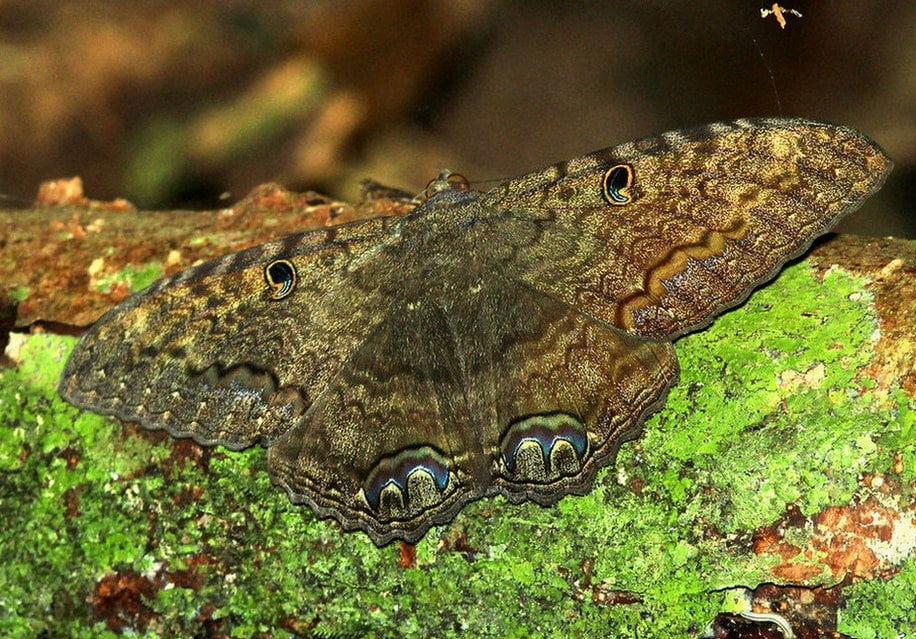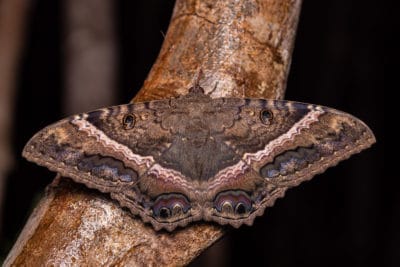Polk County’s Most Wanted – Black Witch moth
Have you seen the Black Witch moth?
Have you seen a massive, bat-shaped, and dark-colored moth? Conserving Carolina and botanist/ecologist David Campbell need your help in locating this month’s “Polk County’s Most Wanted—Animal,” the seasonally appropriate Black Witch moth (Ascalapha odorata). Polk County’s Most Wanted is a community science initiative with a new challenge each month, in which you can expand the scientific understanding of the flora and fauna of Polk County.
How do I identify Black Witch Moth?
The Black Witch moth is nocturnal. It rests during the day and flies at night. Black Witch moths are visually striking insects adorned in funereal tones. They are easily recognized by their large size, a wingspan of up to 7 inches, and pointed forewings.
Males are dark in color and exhibit the plain, grey-brown, mottled pattern commonly associated with moths but with hints of iridescent purple and pink. There is a small spot, often green with orange highlights, on each forewing that is shaped like a number nine, or comma.
Females look similar, however, they are slightly larger than the males, lighter in color, and they have a white, sometimes iridescent, stripe across their open wings.
Where should I look for Black Witch moth?
In the eastern U.S., the only native food plants for this species are the Kentucky Coffee Tree (Gymnocladus dioica) and Locust (Robinia sp.). Like virtually all moths, the adult Black Witch flies mostly at night, attracted to the nectar of flowers, the juices of fallen fruit or the sap of a legume. It rests during the day, oftentimes on walls or under the eaves of entranceways, porches, and garages.
More about the Black Witch moth
The Black Witch moth is a resident of the tropics, ranging from Brazil to the Caribbean and the southernmost portions of Florida and Texas. It is the largest moth in the continental United States.
It is well-documented as a long-distance migrant. It possesses an aerodynamic shape and long, stiff, pointed wings driven by powerful flight muscles. The moths have a proboscis (a straw-like organ that butterflies and some moths use to drink nectar or other fluids) that enables it to refuel during a long journey.
Unlike many fall migrating species, the Black Witch disperses northward in late summer and fall, during the months of July through October. They have been reported from all 50 states and as far north as Newfoundland, Canada. The long-distance excursions by some Black Witch moths are made each fall to search for a mate. While most of these expeditions are in vain, if an individual were successful in finding a mate and a suitable habitat, they may be responsible for establishing a new population and extending the range of the species.
The ability of a large moth to travel from the tropics to our latitude (or farther north) depends on the convergence of several favorable conditions, including the moth’s flying ability, the weather, and timing.
The urge and capability of the Black Witch moth to travel long distances may give the species an advantage in surviving our ever-changing environment and it may improve the species’ ability to expand its range as the climate changes.
This species has never been reported in Polk County but there are reports from both North and South Carolina and as close as Buncombe County, N.C. in July 2015 and Greenville County, S.C. in September 2004. The active hurricane season during fall migration may produce many unusual sightings in our area this year, including the Black Witch moth.
Folklore and mythology
Despite its beauty, substantial size, and notable ability to travel, the Black Witch (as its name suggests) has acquired an ominous reputation in parts of the tropics. In many cultures, this moth is considered a harbinger of death and it is viewed as a bad omen, the embodiment of a lost soul, or a malevolent spirit that is not at rest.
What can you do?
If you think that you have found Black Witch moth in Polk County, please contact Pam Torlina at Conserving Carolina by email at [email protected], and if you can, provide a clear photo, for a definitive confirmation.
For More Information
See more about “Polk County’s Most Wanted.” Download and print a “Pocket Guide” with all of the “Most Wanted” plants, animals, and habitats that you can be on the lookout for when you’re out in the field!
A Biological Inventory of Polk County
Now available for download: “An Inventory of the Significant Natural Areas of Polk County, North Carolina,” a culmination of David Campbell’s seven years in the field documenting the rare and significant flora and fauna in Polk County. Hard copies are available, at cost, on Amazon too!


